
Concept explainers
(a)
Interpretation:
IUPAC name for the parent amine from which the given amine salt is formed has to be given.
Concept Introduction:
IUPAC rules for naming ammonium ions:
There are two rules that has to be followed while naming a positive ion (ammonium ion) and they are,
- In order to name an alkylamine, the ending of the name amine is changed from amine to ammonium ion.
- In order to name an
aromatic amine, the ending of the name “-e” is replaced by “-ium ion”.
- Longest carbon chain has to be identified that is attached to nitrogen atom.
- Suffix “-e” in name of the parent chain
alkane is replaced by “-amine”. - Numbering of the carbon chain is done from the end that is near the nitrogen atom.
- Point of attachment of the nitrogen atom in the carbon chain is indicated by a number before the parent chain name.
- In case if substituents are present, then the identity and location of substituents are appended to the front in the parent chain name.
If the compound contains two amine groups, then the suffix “-e” is replaced by diamine. Tertiary and secondary
Common name for amine is given in a single word. Primary amine is named as alkylamine. Secondary amine is named as alkylalkylamine. Tertiary amine is named as alkylalkylalkylamine.
(a)
Answer to Problem 6.58EP
Name of the parent amine is N-methylethanamine.
Explanation of Solution
Given amine salt is,
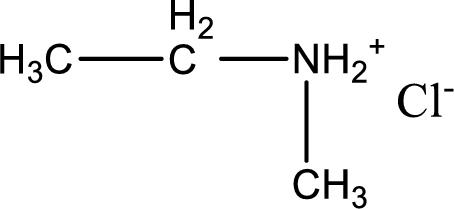
The parent amine can be found by deprotonating the amine salt. This can be accomplished by treating it with a strong base. The complete reaction can be given as,

Structure of the amine is,
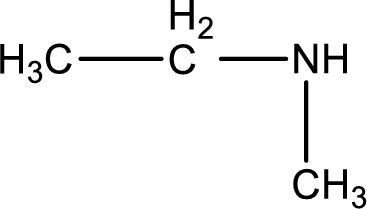
The longest carbon chain attached to the nitrogen atom is found to be containing two carbon atoms. Hence, the parent alkane is ethane. Amine is named by replacing the suffix “-e” in the parent alkane name with “-amine”. This gives the name as ethanamine.
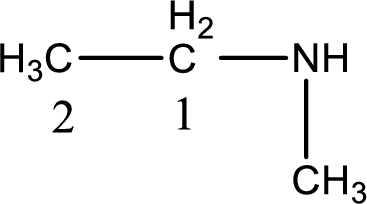
Numbering has to be given from the end that is near to the nitrogen atom. In this case, the nitrogen atom is attached to the carbon atom that is numbered 1. In this case numbering does not make sense as only two carbon atoms are present. Looking for substituent a methyl group is present on the nitrogen atom. This gives the IUPAC name of N-methylethanamine.

IUPAC name for the parent amine is given.
(b)
Interpretation:
IUPAC name for the parent amine from which the given amine salt is formed has to be given.
Concept Introduction:
IUPAC rules for naming ammonium ions:
There are two rules that has to be followed while naming a positive ion (ammonium ion) and they are,
- In order to name an alkylamine, the ending of the name amine is changed from amine to ammonium ion.
- In order to name an aromatic amine, the ending of the name “-e” is replaced by “-ium ion”.
IUPAC nomenclature for amine: There are about five rules to be followed in giving IUPAC name for an amine.
- Longest carbon chain has to be identified that is attached to nitrogen atom.
- Suffix “-e” in name of the parent chain alkane is replaced by “-amine”.
- Numbering of the carbon chain is done from the end that is near the nitrogen atom.
- Point of attachment of the nitrogen atom in the carbon chain is indicated by a number before the parent chain name.
- In case if substituents are present, then the identity and location of substituents are appended to the front in the parent chain name.
If the compound contains two amine groups, then the suffix “-e” is replaced by diamine. Tertiary and secondary amines are named as N-substituted primary amines.
Common name for amine is given in a single word. Primary amine is named as alkylamine. Secondary amine is named as alkylalkylamine. Tertiary amine is named as alkylalkylalkylamine.
(b)
Answer to Problem 6.58EP
Name of the parent amine is 1-butanamine.
Explanation of Solution
Given amine salt is
The parent amine can be found by deprotonating the amine salt. This can be accomplished by treating it with a strong base. The complete reaction can be given as,

Structure of the amine is,

The longest carbon chain attached to the nitrogen atom is found to be containing four carbon atoms. Hence, the parent alkane is butane. Amine is named by replacing the suffix “-e” in the parent alkane name with “-amine”. This gives the name as butanamine.

Numbering has to be given from the end that is near to the nitrogen atom. In this case, the nitrogen atom is attached to the carbon atom that is numbered 1. This has to be added to the name in front. This gives the IUPAC name of 1-butanamine.

IUPAC name for the parent amine is given.
(c)
Interpretation:
IUPAC name for the parent amine from which the given amine salt is formed has to be given.
Concept Introduction:
IUPAC rules for naming ammonium ions:
There are two rules that has to be followed while naming a positive ion (ammonium ion) and they are,
- In order to name an alkylamine, the ending of the name amine is changed from amine to ammonium ion.
- In order to name an aromatic amine, the ending of the name “-e” is replaced by “-ium ion”.
IUPAC nomenclature for amine: There are about five rules to be followed in giving IUPAC name for an amine.
- Longest carbon chain has to be identified that is attached to nitrogen atom.
- Suffix “-e” in name of the parent chain alkane is replaced by “-amine”.
- Numbering of the carbon chain is done from the end that is near the nitrogen atom.
- Point of attachment of the nitrogen atom in the carbon chain is indicated by a number before the parent chain name.
- In case if substituents are present, then the identity and location of substituents are appended to the front in the parent chain name.
If the compound contains two amine groups, then the suffix “-e” is replaced by diamine. Tertiary and secondary amines are named as N-substituted primary amines.
Common name for amine is given in a single word. Primary amine is named as alkylamine. Secondary amine is named as alkylalkylamine. Tertiary amine is named as alkylalkylalkylamine.
(c)
Answer to Problem 6.58EP
Name of the parent amine is N,N-dimethyl-2-propanamine.
Explanation of Solution
Given amine salt is,
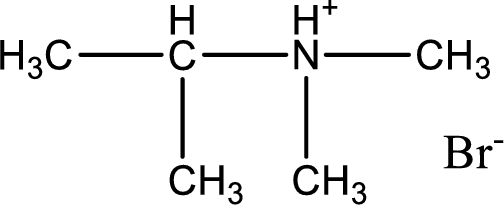
The parent amine can be found by deprotonating the amine salt. This can be accomplished by treating it with a strong base. The complete reaction can be given as,

Structure of the amine is,
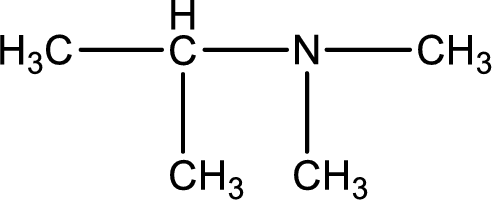
The longest carbon chain attached to the nitrogen atom is found to be containing three carbon atoms. Hence, the parent alkane is propane. Amine is named by replacing the suffix “-e” in the parent alkane name with “-amine”. This gives the name as propanamine.

Numbering has to be given from the end that is near to the nitrogen atom. In this case, the nitrogen atom is attached to the carbon atom that is numbered 2. Looking for substituents, two methyl groups are present on the nitrogen atom. This gives the IUPAC name of N,N-dimethyl-2-propanamine.
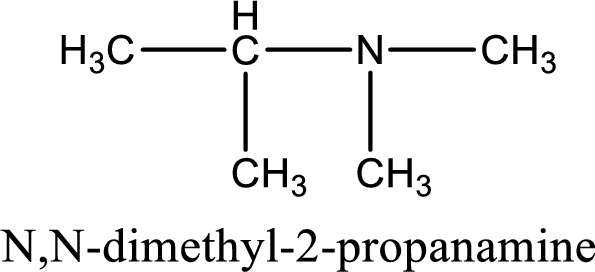
IUPAC name for the parent amine is given.
(d)
Interpretation:
IUPAC name for the parent amine from which the given amine salt is formed has to be given.
Concept Introduction:
IUPAC rules for naming ammonium ions:
There are two rules that has to be followed while naming a positive ion (ammonium ion) and they are,
- In order to name an alkylamine, the ending of the name amine is changed from amine to ammonium ion.
- In order to name an aromatic amine, the ending of the name “-e” is replaced by “-ium ion”.
IUPAC nomenclature for amine: There are about five rules to be followed in giving IUPAC name for an amine.
- Longest carbon chain has to be identified that is attached to nitrogen atom.
- Suffix “-e” in name of the parent chain alkane is replaced by “-amine”.
- Numbering of the carbon chain is done from the end that is near the nitrogen atom.
- Point of attachment of the nitrogen atom in the carbon chain is indicated by a number before the parent chain name.
- In case if substituents are present, then the identity and location of substituents are appended to the front in the parent chain name.
If the compound contains two amine groups, then the suffix “-e” is replaced by diamine. Tertiary and secondary amines are named as N-substituted primary amines.
Common name for amine is given in a single word. Primary amine is named as alkylamine. Secondary amine is named as alkylalkylamine. Tertiary amine is named as alkylalkylalkylamine.
(d)
Answer to Problem 6.58EP
Name of the parent amine is N-methylphenylamine.
Explanation of Solution
Given amine salt is,
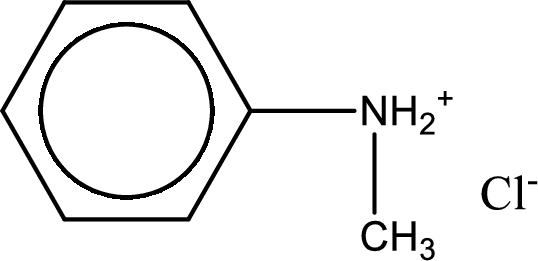
The parent amine can be found by deprotonating the amine salt. This can be accomplished by treating it with a strong base. The complete reaction can be given as,

Structure of the amine is,

The longest carbon chain attached to the nitrogen atom is found to be containing six carbon cyclic chain. Hence, the parent is benzene. This has to be named as phenylamine.
Looking for substituents, one methyl group is present on the nitrogen atom. This gives the IUPAC name of N-methylphenylamine.
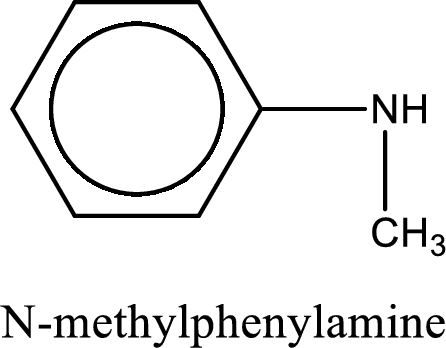
IUPAC name for the parent amine is given.
Want to see more full solutions like this?
Chapter 6 Solutions
Organic And Biological Chemistry
 General, Organic, and Biological ChemistryChemistryISBN:9781285853918Author:H. Stephen StokerPublisher:Cengage Learning
General, Organic, and Biological ChemistryChemistryISBN:9781285853918Author:H. Stephen StokerPublisher:Cengage Learning Organic And Biological ChemistryChemistryISBN:9781305081079Author:STOKER, H. Stephen (howard Stephen)Publisher:Cengage Learning,
Organic And Biological ChemistryChemistryISBN:9781305081079Author:STOKER, H. Stephen (howard Stephen)Publisher:Cengage Learning, Introduction to General, Organic and BiochemistryChemistryISBN:9781285869759Author:Frederick A. Bettelheim, William H. Brown, Mary K. Campbell, Shawn O. Farrell, Omar TorresPublisher:Cengage Learning
Introduction to General, Organic and BiochemistryChemistryISBN:9781285869759Author:Frederick A. Bettelheim, William H. Brown, Mary K. Campbell, Shawn O. Farrell, Omar TorresPublisher:Cengage Learning


